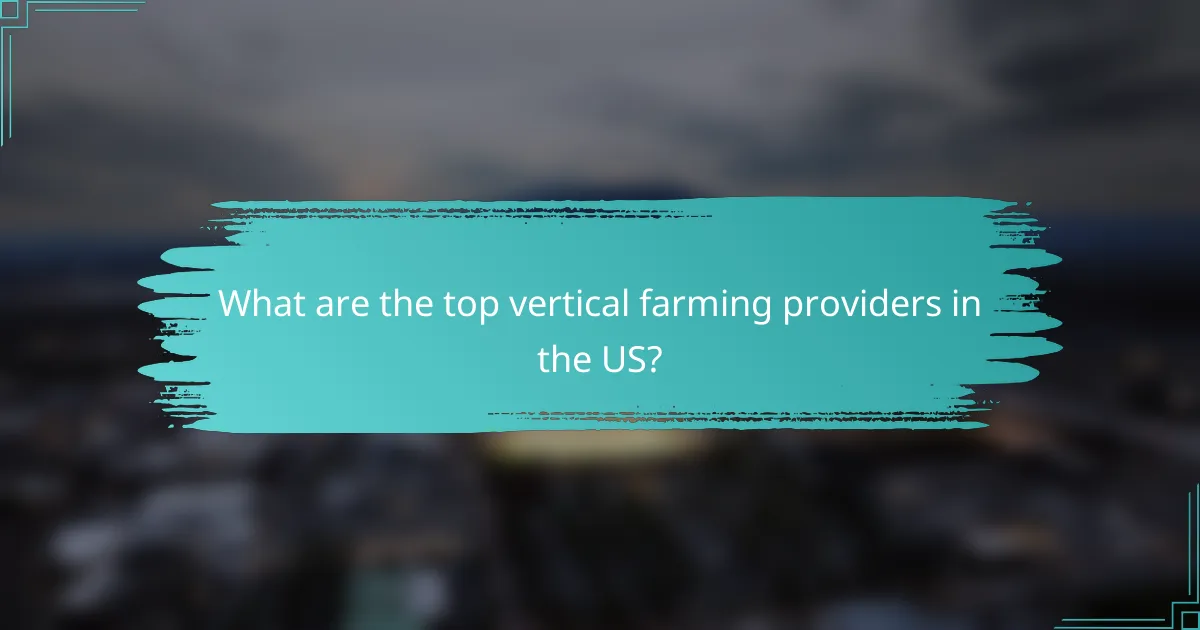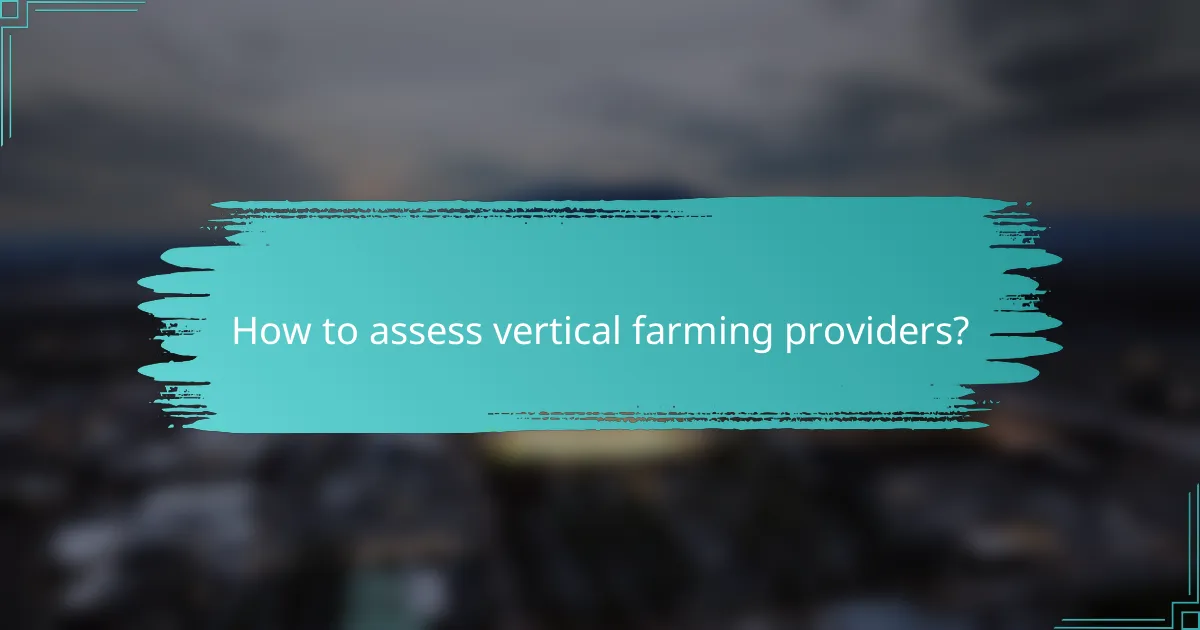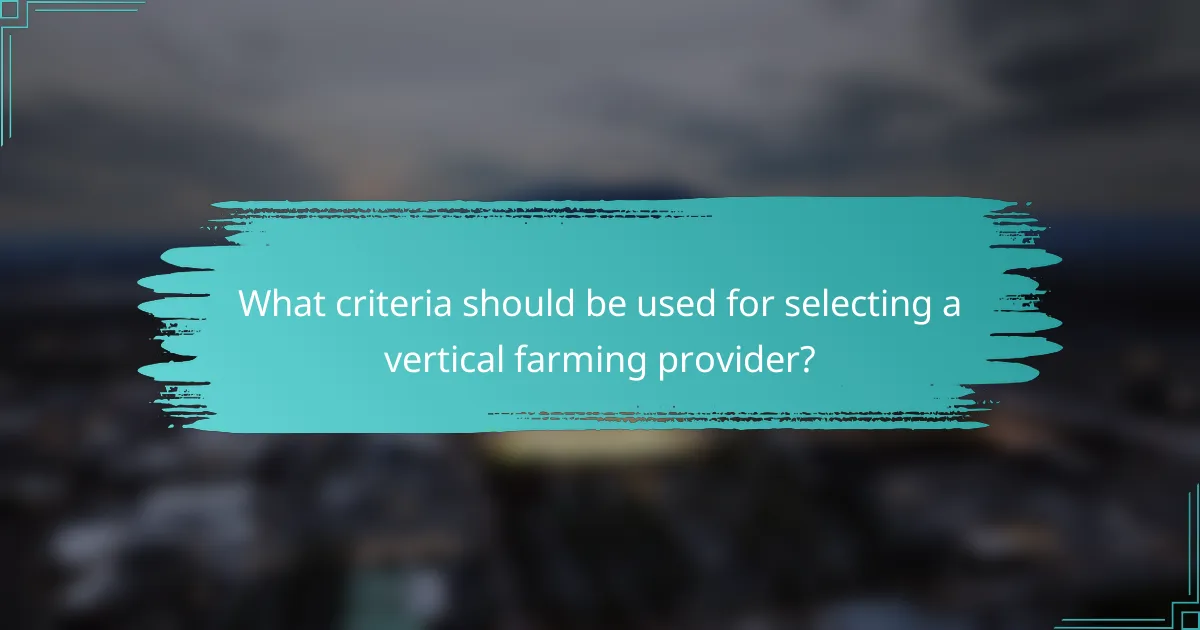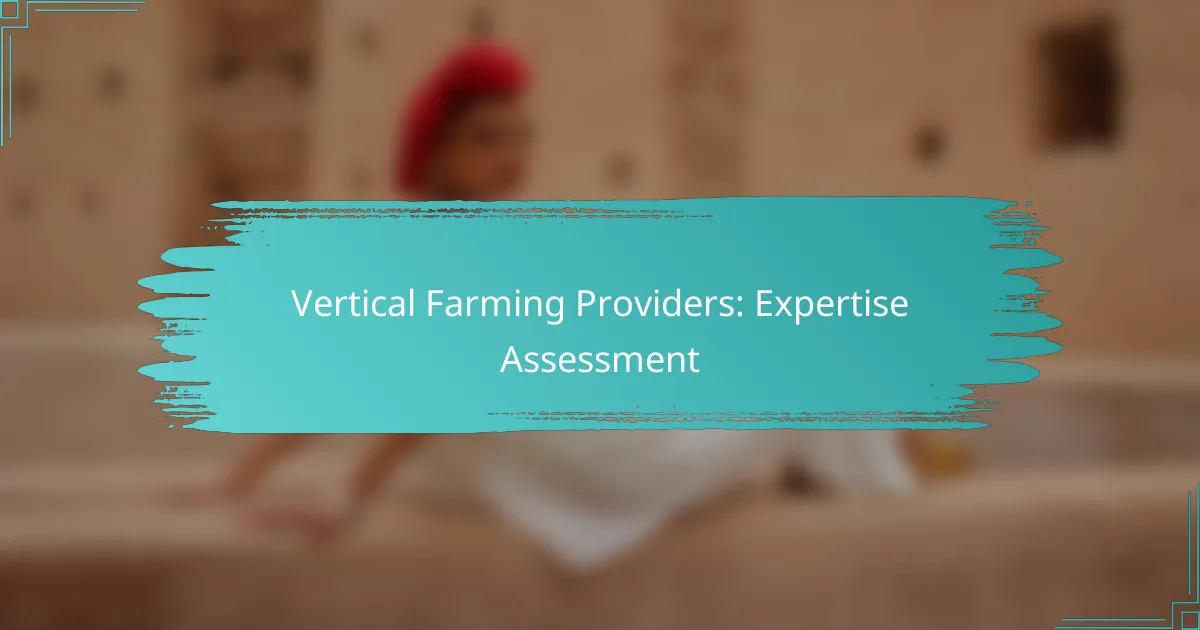Vertical farming providers in the US are revolutionizing sustainable agriculture through innovative technologies that enhance crop yields in urban settings. Companies such as AeroFarms, Plenty, and Bowery Farming are leading the charge, each presenting distinct solutions tailored to meet diverse agricultural needs. To evaluate these providers effectively, consider their technological advancements, sustainability practices, and production capacities, which are crucial for aligning with your agricultural objectives.

What are the top vertical farming providers in the US?
The leading vertical farming providers in the US are known for their innovative approaches to sustainable agriculture, utilizing advanced technology to maximize crop yields in urban environments. Companies like AeroFarms, Plenty, Bowery Farming, Green Spirit Farms, and Vertical Harvest are at the forefront, each offering unique solutions and operational models.
AeroFarms
AeroFarms is a pioneer in the vertical farming industry, utilizing aeroponic technology to grow leafy greens without soil. Their farms use up to 95% less water than traditional agriculture and can produce crops year-round, regardless of climate conditions.
The company focuses on sustainability and has received numerous awards for its innovative practices. AeroFarms operates facilities in Newark, New Jersey, and has plans for expansion, making it a key player in the urban farming landscape.
Plenty
Plenty is known for its high-tech vertical farms that leverage advanced robotics and artificial intelligence to optimize plant growth. Their farms are designed to produce a variety of crops, including herbs and greens, with minimal environmental impact.
Based in San Francisco, Plenty emphasizes local food production, aiming to reduce transportation emissions. Their unique growing systems can yield up to 350 times more produce per square foot compared to traditional farming methods.
Bowery Farming
Bowery Farming operates smart indoor farms that utilize proprietary technology to monitor and control growing conditions. This allows them to produce pesticide-free crops while minimizing resource use.
With facilities in New York and New Jersey, Bowery focuses on delivering fresh produce to urban consumers. Their commitment to sustainability includes using renewable energy sources and reducing food waste through efficient supply chain practices.
Green Spirit Farms
Green Spirit Farms specializes in growing a wide range of crops using vertical farming techniques that emphasize sustainability. They utilize hydroponic systems to cultivate plants without soil, which conserves water and space.
Located in Michigan, Green Spirit Farms aims to provide fresh produce to local markets and reduce reliance on imported goods. Their approach includes community engagement and education about the benefits of vertical farming.
Vertical Harvest
Vertical Harvest is unique in its mission to combine vertical farming with social impact, providing job opportunities for individuals with disabilities. Their farm in Jackson, Wyoming, produces a variety of crops while fostering an inclusive workplace.
The company employs hydroponic systems to maximize yield and efficiency, focusing on local distribution. Vertical Harvest’s model demonstrates how vertical farming can address both food production and social challenges in communities.

How to assess vertical farming providers?
To assess vertical farming providers, focus on their technology, sustainability practices, and production capacity. These factors will help determine their effectiveness and alignment with your agricultural goals.
Evaluate technology and innovation
When evaluating vertical farming providers, consider the technology they use for growing crops. Look for innovations such as hydroponics, aeroponics, and advanced lighting systems that enhance growth efficiency and yield. Providers that invest in cutting-edge technology are more likely to deliver consistent results.
Additionally, assess their automation capabilities. Automated systems can reduce labor costs and improve precision in nutrient delivery and environmental control. A provider with a strong technological foundation is better positioned to adapt to future agricultural challenges.
Review sustainability practices
Sustainability is crucial in vertical farming. Investigate the provider’s practices regarding energy use, water conservation, and waste management. Providers that utilize renewable energy sources and implement water recycling systems demonstrate a commitment to reducing their environmental footprint.
Also, check for certifications or adherence to sustainability standards. Certifications like LEED or organic farming practices can indicate a provider’s dedication to eco-friendly operations. This can be a deciding factor for consumers increasingly concerned about environmental impact.
Analyze production capacity
Understanding a provider’s production capacity is essential for assessing their ability to meet demand. Look for details on the square footage of their growing area and the types of crops they can produce. A provider with a larger capacity can often supply more customers or larger orders.
Additionally, inquire about their crop turnover rates. Efficient providers can produce multiple harvests per year, maximizing output. Comparing production capacities among providers can help you choose one that aligns with your business needs and growth plans.

What are the benefits of vertical farming?
Vertical farming offers several advantages, including maximizing space, conserving water, and reducing transportation costs. These benefits make it an attractive option for urban agriculture and sustainable food production.
Space efficiency
Vertical farming utilizes stacked layers of crops, allowing for a higher yield per square meter compared to traditional farming. This method is particularly beneficial in urban areas where land is scarce and expensive. For example, a vertical farm can produce the same amount of food as several acres of conventional farmland.
By optimizing the use of vertical space, growers can significantly increase their output without requiring additional land. This efficiency is crucial in densely populated regions where land availability is limited.
Water conservation
Vertical farms use advanced hydroponic and aeroponic systems that require up to 90% less water than traditional agriculture. This reduction is achieved by recycling water within the system, minimizing waste. Such practices are essential in areas facing water scarcity or strict regulations on water usage.
Implementing water-efficient technologies not only conserves resources but also lowers operational costs. Growers can benefit from reduced water bills while contributing to sustainable practices in agriculture.
Reduced transportation costs
By situating vertical farms closer to urban centers, transportation costs can be significantly decreased. Fresh produce can be delivered to consumers within hours, reducing spoilage and enhancing food quality. This proximity also lowers the carbon footprint associated with long-distance food transport.
Moreover, local sourcing of food can lead to better pricing for consumers and increased profitability for producers. As urban populations grow, the demand for fresh, locally grown food will likely continue to rise, making vertical farming a viable solution.

What are the challenges faced by vertical farming providers?
Vertical farming providers encounter several significant challenges that can impact their operations and profitability. Key issues include high initial investment costs, substantial energy consumption, and varying levels of market acceptance for their products.
High initial investment
The initial investment for vertical farming can be quite substantial, often ranging from hundreds of thousands to millions of dollars. This includes costs for technology, infrastructure, and equipment such as LED lighting, hydroponic systems, and climate control systems.
Providers must carefully assess their financing options, which may include loans, grants, or partnerships. A clear business plan that outlines potential returns on investment can help attract funding and mitigate financial risks.
Energy consumption
Energy consumption is a critical concern for vertical farming, as these systems often rely heavily on artificial lighting and climate control. Energy costs can account for a significant portion of operational expenses, sometimes exceeding 30% of total costs.
To manage energy use effectively, providers can explore renewable energy sources, such as solar or wind, and implement energy-efficient technologies. Monitoring energy consumption and optimizing operational schedules can also help reduce costs.
Market acceptance
Market acceptance of vertically farmed products can vary significantly based on consumer awareness and preferences. While some consumers embrace the sustainability and freshness of these products, others may be hesitant due to perceived higher prices or unfamiliarity.
To improve market acceptance, providers should focus on educating consumers about the benefits of vertical farming, such as reduced pesticide use and local sourcing. Engaging in community outreach and partnerships with local retailers can also enhance visibility and acceptance.

What criteria should be used for selecting a vertical farming provider?
Selecting a vertical farming provider requires careful consideration of several key criteria, including cost-effectiveness, technology, and support services. These factors will determine the provider’s ability to meet your specific agricultural needs and ensure a successful operation.
Cost-effectiveness
Cost-effectiveness is a crucial criterion when choosing a vertical farming provider, as it directly impacts your overall investment and profitability. Assess both initial setup costs and ongoing operational expenses to understand the total cost of ownership.
Consider factors such as equipment pricing, energy consumption, and maintenance costs. For instance, providers that offer energy-efficient systems may have higher upfront costs but lower long-term expenses, making them more cost-effective over time.
It’s also wise to compare financing options and potential subsidies available in your region. In some areas, government incentives for sustainable agriculture can significantly reduce costs, so be sure to explore these opportunities when evaluating providers.
